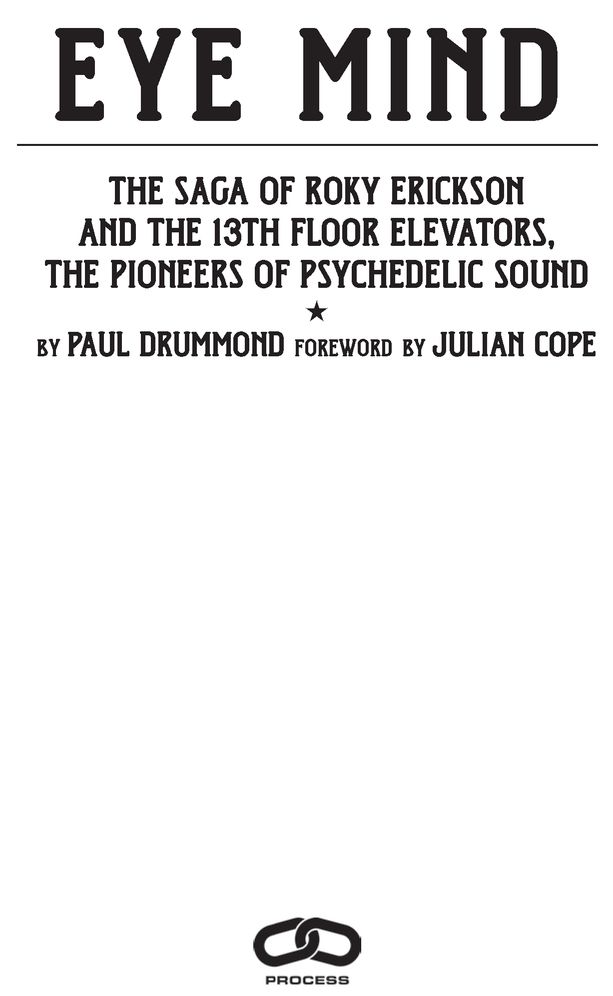Table of Contents
This book is dedicated to Stacy Keith Sutherlanda true Texan musical pioneerand to those who contributed but sadly passed away prior to publication.
RIP
Daniel Galindo, Pamela Bailey, Roger Erickson,
Chester Helms, Jack Jackson, Jerry Lightfoot,
Sandy Lockett, Cecil Morris, Tary Owens, Lelan Rogers,
Doug Sahm, G.C. Sutherland.
FOREWORD
Until now, the history of the 13th Floor Elevators has been one of the most important and exhilarating rock n roll stories still awaiting the telling: an essential tale of truth-seeking, desert revelations, apostasy, pursuit by the lawmen, ignominious decline and dissolution, death and madness, rehabilitation andultimatelyreconciliation. But our heroes psychedelicized 1960s story has lingered out of reach thus far into the early twenty-first century because too many of its protagonists remained locked in a post-psychedelic fall-out, too close to the story to have the motivation to return there in order to retrieve it in text form, and too wary of strangers to open up and bring forth the hidden truths as they had each lived them. Until now, that is, when all involved have at last been corralled and interrogated by a fastidious outsider who took it upon himself to do the proper Sherlock Holmesian excavations necessary in order to bring us a Texan truth worthy of its founding fathers: Tommy Hall, Roky Erickson, Stacy Sutherland, John Ike Walton and Benny Thurman. Eight years or more in the researching, the endless to-ing and fro-ing to Texasits all here in this book. Such is the mindset of the obsessive visionary, and not for one moment do I believe that this task could have been carried out to completion by anyone less than a man of extraordinary strength and determination. Im honored to say that man is my dear friend and a relentless pursuer of timeless truths, Paul Drummond. Hes done it. I can hardly believe it, but the marathon is finally over. Please excuse my zealous enthusiasm, but this history of the 13th Floor Elevators is nothing short of a holy text.
Julian Cope
The Marlborough Downs
INTRODUCTION
It is important that people grasp the idea that we are not afraid of nothingness. There is no empty space in nature, which we do not believe that, at one time, or another, the human mind can fill. It is clear what a terrible task we have undertaken, we aim to do nothing less than return to the sources, human or inhuman, of the theatre and raise it from the dead. All that partakes of the obscurity and magnetic fascination of dreams, those dark strata of consciousness which are all that concern us in mind, we want to see all this radiate and triumph on stage, even if it means destroying ourselves and exposing ourselves to the ridicule of a colossal failure. Nor are we afraid of the kind of commitment our effort represents. We conceive of the theatre as an authentic performance of magic. We do not address ourselves to the eyes, or to the direct emotion of the soul, what we are trying to create is a certain psychological emotion in which the inmost motives of the heart will be laid bare toward this ideal theatre we ourselves are groping blindly Regardless of the degree of success of our performances, those who attend them will understand that they are participating in a mystical experiment by which an important part of the domain of the mind and consciousness may be definitively saved or lost.
Antonin Artaud,Manifesto for a Theatre That Failed, November 13, 1926
The 13th Floor Elevators cannot be compared to any other group in musical history. While the band were formed in Texas and existed from late 1965 to mid-1969, they were never truly members of the hippie culture, remaining strange anomalies and, ultimately, outsiders. Their story is a drama of the division between mind and bodythe evolution of ideas and the development of music. The extent of their adhesion to a self-imposed, quasi-religious doctrine based around hallucinogens was remarkable, as was their unfaltering belief that they would discover new paths to enlightenment and a clearer understanding of the divine fabric of matter itself. While their story is a familiar progressionthe struggle for initial success, the momentary fruition and the inevitable downfallit is more interestingly the true secret history of psychedelia in America. The story of a triumvirate who engaged the new medium of pop music to try and seriously express the newly perceived realities of the psychedelic experience.
Roky Erickson was the frontman and face of the band. A musically and theatrically gifted teenage singer, he possessed powerful vocal dynamics that could rival the most exciting and high-octane black performers of the era. Tommy Hall, an overly intelligent chemical engineering student, became their Svengali lyricist, proselytizing the psychedelic experience with evangelical zeal. Stacy Sutherland, a country boy from a simple farming background, possessed a deep foundation in roots music and became the architect of their new, unique sound.
Although they invented the idea of psychedelic music, their early association with hallucinogens, although legal, led to a dangerous existence, leaving them virtual outlaws during the psychedelic summer of 67. If Robert Johnson laid the foundation of popular music, then the 13th Floor Elevators seeded the roots of alternative music, absolutely refusing to compromise their message or music despite being constantly hounded by the authorities. They were the natural descendents of the country outlaws of the generation before them, and extolled the punk ethos a decade too soon. Although there were many refugees of the Sixties, the Elevators saga reads like a rollercoaster ride to the end of the decade. By the end of 1969, Roky virtually re-enacted the plot of One Flew Over the Cuc koos Nest when he pleaded insanity and was incarcerated in a maximum security unit of a prison for the criminally insane, Stacy was imprisoned in the jail Roky attempted to avoid, Tommy spent two years living in a cave with an LSD mafia cult, their bassist was drafted to Vietnam and the drummer was given involuntary shock treatments.
While the postwar boom accelerated American manufacturing and consumerism, no one foresaw the rise of a youth counterculture that would challenge the fabric of society from within. While much has been written about this period, particularly focusing on the celebrated San Franciscan scene, the Texas connection and the Elevators story have remained a hidden history of the decade. While the 13th Floor Elevators can be viewed as an extreme example they in fact represented a microcosm of wider developments. What must be remembered at all times is the simple fact that as of 1965 there was no drug culture as we know it. Hallucinogens were legal, samples were being handed out unabated by chemical manufacturing corporations and drug testing was taking place on many university campuses. However, the vision of utopia that many tried to achieve by turning on led to a massive toxic overload by the end of the decade. New substances entering the equation, leading to the creation of a fully-fledged drug scene, facilitated this.
While much was achieved during the Sixties in the realm of social /racial/sexual politics, the attempt to form a new psychedelic society ultimately became self-defeating. Although the counterculture spawned many new mediums, it was the music scene (with its viable commodities: graphics, posters, magazines and records) that brought the revolution and the corporation into face-to-face confrontation. The counterculture didnt possess the means or infrastructure to distribute its wares. For a split second everything was new, pure and untarnished, before the scruples of the unifying ideology (freedom from reclaiming the individual and building new community values, not based on personal greed) became compromised by having to broker deals with the outside world. While some bands started by manufacturing their own product, these were really devices for attracting deals with major record labels. The politics of how musicians negotiated with corporations was won and lost on an individual basis; there was no template for dealing with straight society.












